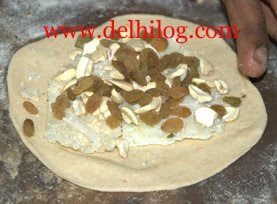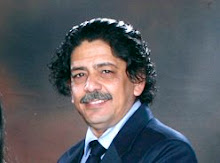 12
comments
|
Sunday, April 27, 2008
12
comments
|
Sunday, April 27, 2008
A decade-and-a-half had passed since the Mutiny. Chandni Chowk had started settling under the new governance of the British. Year 1872 - Pt. Gaya Prasad, a yong man in early twenties, left his home in Tehsil Bah in Agra and came to Delhi in search of greener pasture. He put up a shop in a lane entering the Kinari Bazaar in Chandni Chowk and started making hot and sizzling paranthas. Soon the popularity of his paranthas grew so much that he had to call his brothers and cousins to help him in the business. Gradually, there came up almost a score shops - all belonging to the extended families of Gaya Prasad. Little they would have realised and imagined that the lane itself would become popular and famous after their paranthas as Paranthe Wali Gali (Lane of Paranthas) !

Thirty five varieties of Paranthas are served in the four shops that are now left in this
 lane. The fillings range from the usual, aaloo (mashed potatoes), gobhi (grated cauliflower), gaajar (carrots), mooli (radish) and paneer (cottage cheese); to the adventurous, methi (fenugreek), pudina (mint), karela (bittergourd), bhindi (okra); to the exotic, kela (banana), khurchan (thick layer of cream) and dry fruits. The usual fillings are rolled into a ball of dough
lane. The fillings range from the usual, aaloo (mashed potatoes), gobhi (grated cauliflower), gaajar (carrots), mooli (radish) and paneer (cottage cheese); to the adventurous, methi (fenugreek), pudina (mint), karela (bittergourd), bhindi (okra); to the exotic, kela (banana), khurchan (thick layer of cream) and dry fruits. The usual fillings are rolled into a ball of dough and flattened with a rolling pin on a wooden or marble base. In the exotic parathas, the filling is spread on a flattened layer of dough and covered with another layer. The layers are then neatly tied and are ready to fry.Unlike the usual way of frying the parathas on a 'tawa' (flat griddle), the parathas in the Parathe Wali Gali are fried in a 'kadahi' (iron wok).
and flattened with a rolling pin on a wooden or marble base. In the exotic parathas, the filling is spread on a flattened layer of dough and covered with another layer. The layers are then neatly tied and are ready to fry.Unlike the usual way of frying the parathas on a 'tawa' (flat griddle), the parathas in the Parathe Wali Gali are fried in a 'kadahi' (iron wok). The parathas, fried in the 'desi ghee' (clarified butter) are then served in a 'thali' accompanied by 'kaddu (pumpkin) ki sabzi', 'aaloo mattar' (potatoes and green peas), 'aaloo mattar paneer' (potatoes, green peas and cottage cheese in gravy) 'kele ki saunth' (slices of bananas in thick jaggery and dried ginger chutney) and pudina (mint) chutney.
The parathas, fried in the 'desi ghee' (clarified butter) are then served in a 'thali' accompanied by 'kaddu (pumpkin) ki sabzi', 'aaloo mattar' (potatoes and green peas), 'aaloo mattar paneer' (potatoes, green peas and cottage cheese in gravy) 'kele ki saunth' (slices of bananas in thick jaggery and dried ginger chutney) and pudina (mint) chutney. The choice of vegetables and chutneys, served as accompaniments, have remained unchanged all these years.
The choice of vegetables and chutneys, served as accompaniments, have remained unchanged all these years.The owners mention - with a gleaming pride - about the celebrities who have savoured the sumptuous parathas at their joints. Among these are Kabir Bedi, Salma Agha, Akshay Kumar, Gauri (wife of Shahruk Khan) and Amithab Bachhan. The shop of Pt. Gaya Prasad Shiv Charan (claimed as the first shop among the lot) has proudly displayed a unique picture of Pt. Jawaharlal Nehru along with Vijaylaksmi Pandit (Nehru's sister) Indira Gandhi and Babu Jagjivan Ram dining at Parathe Wali Gali eating the paratnthas served in 'pattal' (plates made of leaves) and 'kullhad' (bowls made of clay)
 Paranthe Wali Gali has seen more than a century and a quarter go by. And all through, it has been a major destination for the locals as well as the tourists who throng the place to satiate their gastronomical pleasures. All but four shops are now left in the lane. Many, from the original count of nearly a score, have diversified into other business. But those who have chosen to remain in the traditional business speak high of Mr. Sreedharan, the doyen of Delhi Metro.
Paranthe Wali Gali has seen more than a century and a quarter go by. And all through, it has been a major destination for the locals as well as the tourists who throng the place to satiate their gastronomical pleasures. All but four shops are now left in the lane. Many, from the original count of nearly a score, have diversified into other business. But those who have chosen to remain in the traditional business speak high of Mr. Sreedharan, the doyen of Delhi Metro. Anjali, the sixth generation female owner of the shop Pt. Baburam Devidayal, feels indebted to Delhi Metro for bringing in more and more customers from the far flung areas of Delhi. The Chandni Chowk station of the Delhi Metro opens right in front of the Paranthe Wali Gali.
Anjali, the sixth generation female owner of the shop Pt. Baburam Devidayal, feels indebted to Delhi Metro for bringing in more and more customers from the far flung areas of Delhi. The Chandni Chowk station of the Delhi Metro opens right in front of the Paranthe Wali Gali.


